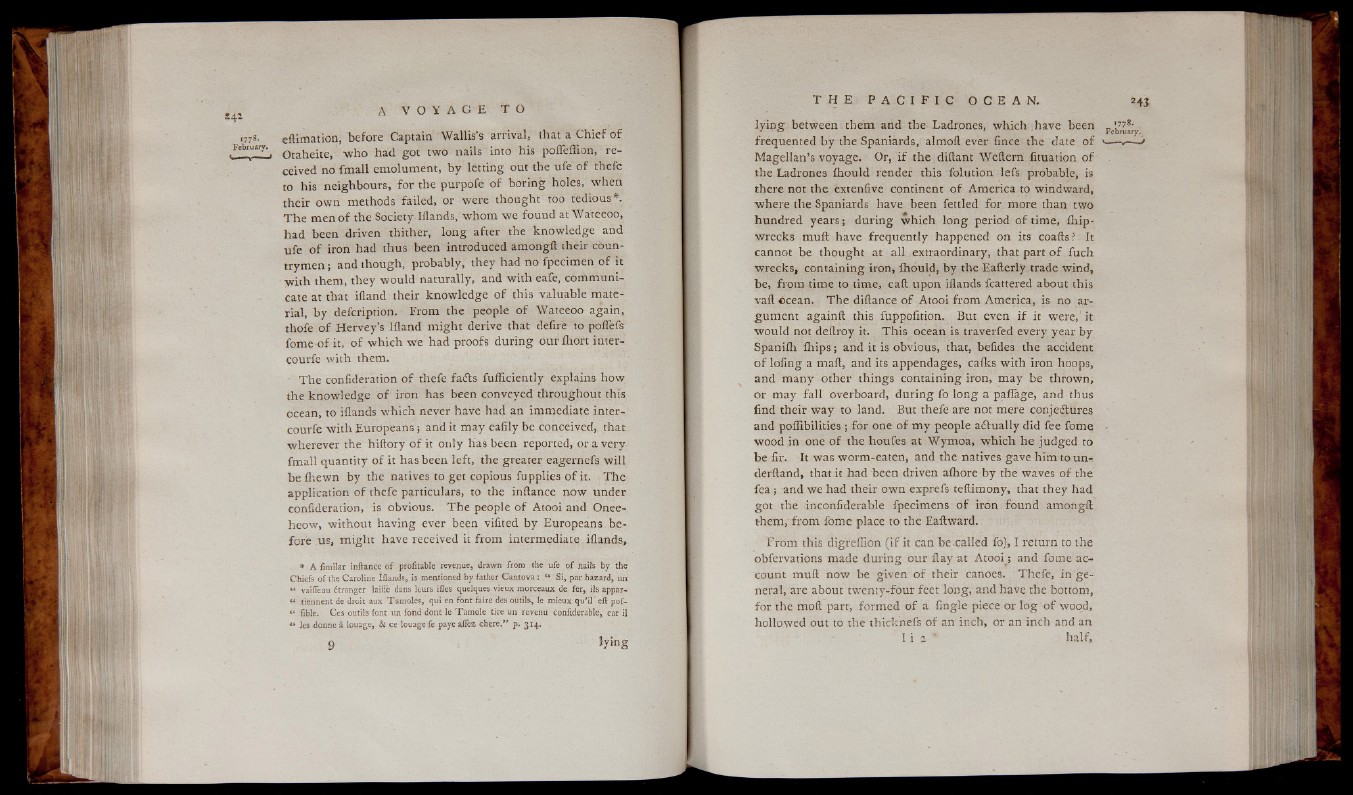
eftimation, before Captain Wallis's arrival, that a C h ief o f
Otaheite, w ho had got two nails into his pofleflion, received
no fmall emolument, b y letting out the ufe o f thefe
to his neighbours, for the purpofe o f boring holes, when
their own methods failed, or were thought too tedious*.
T h e men o f the Society Iilands, whom w e found at Wateeoo,
had been driven thither, long after the knowledge and
ufe o f iron had thus been introduced amongft their countrymen;
and though, probably, they had no fpecimen o f it
w ith them, they would naturally, and with eafe, communicate
at that ifland their kn owledge o f this valuable material,
by defcription. From the people o f Wateeoo again,
thofe o f Hervey’s Ifland might derive that delire to polTefs
fome o f it, o f w h ich we had proofs d uring o u r ih o rt inter-
courfe with them.
T h e confideration o f thefe fa ils fufficiently explains how
the knowledge o f iron has been conveyed throughout this
ocean, to iflands which never have had an immediate inter-
courfe w ith Europeans ; and it may ealily be conceived, that
wherever the hiftory o f it only has been reported, or a very
fmall quantity o f it has been left, the greater eagernefs w ill
be Ihewn by the natives to get copious fupplies o f it. The
application o f thefe particulars, to the inftance now under
confideration, is obvious. T h e people o f Atooi and Onee-
heow, without having ever been vifited by Europeans before
us, might have received it from intermediate iflands,
* A fimilar inftance o f profitable revenue, drawn from the ufe o f hail’s by the
Chiefs o f the Caroline iflands, is mentioned by father Cantova : “ 'S i , par hazard, un
« vaiflèau étranger laifïè dans leurs ifles quelques vieux morceaux de fer, ils appar-
“ tiennent de droit aux Tamoles, qui en font faire des outils, le mieux qu’il^eft pof-
“ fible. Ces outils font un fond dont le Tamole tire un revenu confiderable^ car il
“ les donne à louage, & ce louage fe paye afîez chere.” p. 314,
ly in g between them and the Ladrones, which have been Fe'b^®'
frequented by the Spaniards, almoft ever fince the date o f <— «—
Magellan’s voyage. Or, i f the diftant Weflern fituation o f
the Ladrones fhould render this folution lefs probable, is
there not the extenfive continent o f America to windward,
where the Spaniards have been fettled for more than two
hundred y ea rs; during w h ich long period o f time, ihip-
wrecks mult have frequently happened on its coafts? It
cannot be thought at all extraordinary, that part o f fuch
wrecks, containing iron, fhould, b y the Eafterly trade wind,
be, from time to time, call upon iflands fcattered about this
vaft ocean. T he diftance o f Atooi from America, is no argument
againft this fuppofition. But even i f it w e r e ,'it
wou ld not deftroy it. T his ocean is traverfed every year by
Spanifh ih ip s ; and it is obvious, that, befides the accident
o f lofing a mail, and its appendages, caiks with iron hoops,
and many other things containing iron, may be thrown,
or may fa ll overboard, during fo long a paflage, and thus
find their w a y to land. But thefe are not mere conjedlures
and poflibilities ; fo r one o f m y people a ilu a lly did fee fome -
wood in one o f the houfes at Wymoa, w hich he judged to
be fir. It was worm-eaten, and the natives gave him to un-
derftand, that it had been driven afhore by the waves o f the
fea ; and we had their own exprefs teftimony, that they had
got the inconfiderable fpecimens o f iron found amongft
them,'from fome place to the Eaftward.
From this digreffion ( i f it can be called fo), I return to the
obfervations made during our ftay at Atooi ; and fome account
muft now be given o f their canoes. Thefe, in ge neral,
are about twenty-four feet long, and have the bottom,
for the moft part, formed o f a fingle piece or lo g o f wood,
hollowed out to the thicknefs o f an inch, or an inch and an
l i e * ha lf,